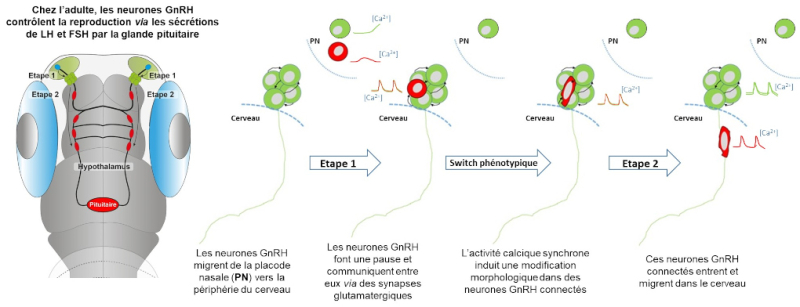During the course of evolution, communication between individuals has been essential for their adaptation to a new environment and the preservation of the species. This study, published in the journal Science Advances, shows that this is also the case for the migration of the small population of Gonadotropin-Releasing Hormone (GnRH) neurons (around 2,000 cells in humans and ~100 in zebrafish) which controls reproduction in all vertebrates.
In humans and all vertebrates, the survival of the species depends on an essential stage of embryonic development: the migration of neurons synthesizing and secreting GnRH from the nasal placode to the brain where they join the hypothalamus to control the release of pituitary gonadotropins (LH and FSH) and thus reproduction. This work provides a new view of this migration by using transgenic zebrafish larvae as a vertebrate model and longitudinal in vivo multiphoton imaging.
The researchers show that these neurons pause at the border between the nasal placode and the brain where they form an inter-hemisphere network that is synaptically isolated from the rest of the brain. Only the neurons which integrate into this network and which are able to communicate with neighboring GnRH cells using the neurotransmitter glutamate, will be able to finally change morphology. This change will then allow them to cross the barrier and continue their migratory journey to their final and functional destination in the hypothalamus, deep inside the brain. The synaptic communication between GnRH neurons is so robust at this stage of brain development, that partial ablation of neurons at the placode-brain interface does not disrupt the migration of GnRH neurons from the other hemisphere.
This study reveals a new concept of GnRH neuron migration in which GnRH neurons function more as a connected population than as individual units. It could also shed new light on the origin of reproductive pathologies and infertility in humans, such as those observed in patients with Kallmann syndrome and pave the way for new genetic screens.

Illustration of the mode of migration in a connected network of GnRH neurons which control reproduction in vertebrates and preservation of the species (model: zebrafish larva)


